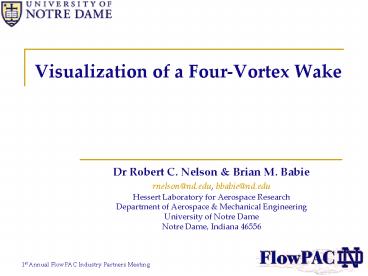Visualization of a FourVortex Wake - PowerPoint PPT Presentation
1 / 12
Title:
Visualization of a FourVortex Wake
Description:
1st Annual FlowPAC Industry Partners Meeting. Visualization of a Four-Vortex Wake ... Identify: wavelength, core size, vorticity distribution, circulation strength ... – PowerPoint PPT presentation
Number of Views:62
Avg rating:3.0/5.0
Title: Visualization of a FourVortex Wake
1
Visualization of a Four-Vortex Wake
- Dr Robert C. Nelson Brian M. Babie
- rnelson_at_nd.edu, bbabie_at_nd.edu
- Hessert Laboratory for Aerospace Research
- Department of Aerospace Mechanical Engineering
- University of Notre Dame
- Notre Dame, Indiana 46556
2
Motivation for Research
- Aircraft trailing vortex wakes can be a hazard to
other aircraft - In flight wake vortex encounters cause control
problems for aircraft - Roll excursions
- Increased structural loading factors
- Wake hazard limits airport capacity due to
aircraft spacing - Two methods for addressing the wake encounter
problem - Wake prediction and avoidance
- Influence of wake vortex stability
- Focus of this research is to excite wake
instabilities such that a rapid attenuation of
the wake is achieved - Need to understand flow physics of vortex decay
- How can vortex instability mechanisms be
enhanced?
3
Research Program Objectives
- To obtain a qualitative understanding of the
configurations that are conducive to rapid
amplification of instabilities - Based on ?2/ ?1 and b2/b1
- Identification of instability types/modes that
are responsible for wake vortex attenuation - Identify wavelength, core size, vorticity
distribution, circulation strength - Attempt to actively perturb experimental wake
- Plasma actuation
- Control surface oscillation
- Relate experimental results directly to aircraft
variables - Calculate induced rolling moment
4
Aircraft Wake at Cruise Altitude
Photo taken from http//www.airliners.net
5
Wake Upset Video
Video clip courtesy of the Boeing Corporation
6
The Four-Vortex System
- Why study a four-vortex wake?
- A four-vortex model is selected as it represents
an aircraft wake in a high-lift configuration
TIP VORTEX
FLAP VORTEX
Photo taken from http//www.airliners.net
Counter-rotating configuration
7
Large Subsonic Wind Tunnel Facility
8
Four-Vortex Wake Experiment
Artist rendition of wake facility at Notre Dame
Near-field Helium bubble visualization
9
Four-Vortex Wake Visualization
Wing models
Outer core
Inner core
Vortex cores
- Further details on experimental results presented
in publications - 23rd AIAA Applied Aerodynamics Conference, AIAA
2005-4852, Toronto, ON, June 2005. - 11th Intl Symposium on Flow Visualization, paper
103, Notre Dame, IN, August 2004.
10
Summary
- An experimental apparatus has been developed to
generate a wake consisting of four vortices - A four-vortex model was selected as it represents
a simplified model of an aircraft during take-off
and landing - The apparatus permits the control of the
circulation strength of each vortex as well as
the spacing between vortices - The facility may be used to study both
co-rotating and counter-rotating configurations - The large subsonic tunnel allows for
visualization of the wake up to 30 spans
downstream of generation - Helium bubbles are excellent for marking wake
vortices - Symmetric instability modes were observed in the
far-field of the wake
11
Proposed Future Experimentation
- Identify dominant instability types/modes
responsible for wake dynamics - Flow visualization
- Wavelength/Amplitude measurements
- Use of PIV for detailed flow-field surveys
- Knowing the dominant instability modes, it should
be possible to actively perturb the wake - Frequency and location of perturbations known a
priori - Methods for perturbing wake include
- Plasma actuation
- Oscillating control surfaces
- Use of PIV to measure velocity for actively
controlled wakes - Relation of measurements to aircraft variables
- Calculation of rolling moment induced on
following wing model - Compare results to uncontrolled case
12
Questions?
Photo taken from http//www.airliners.net































